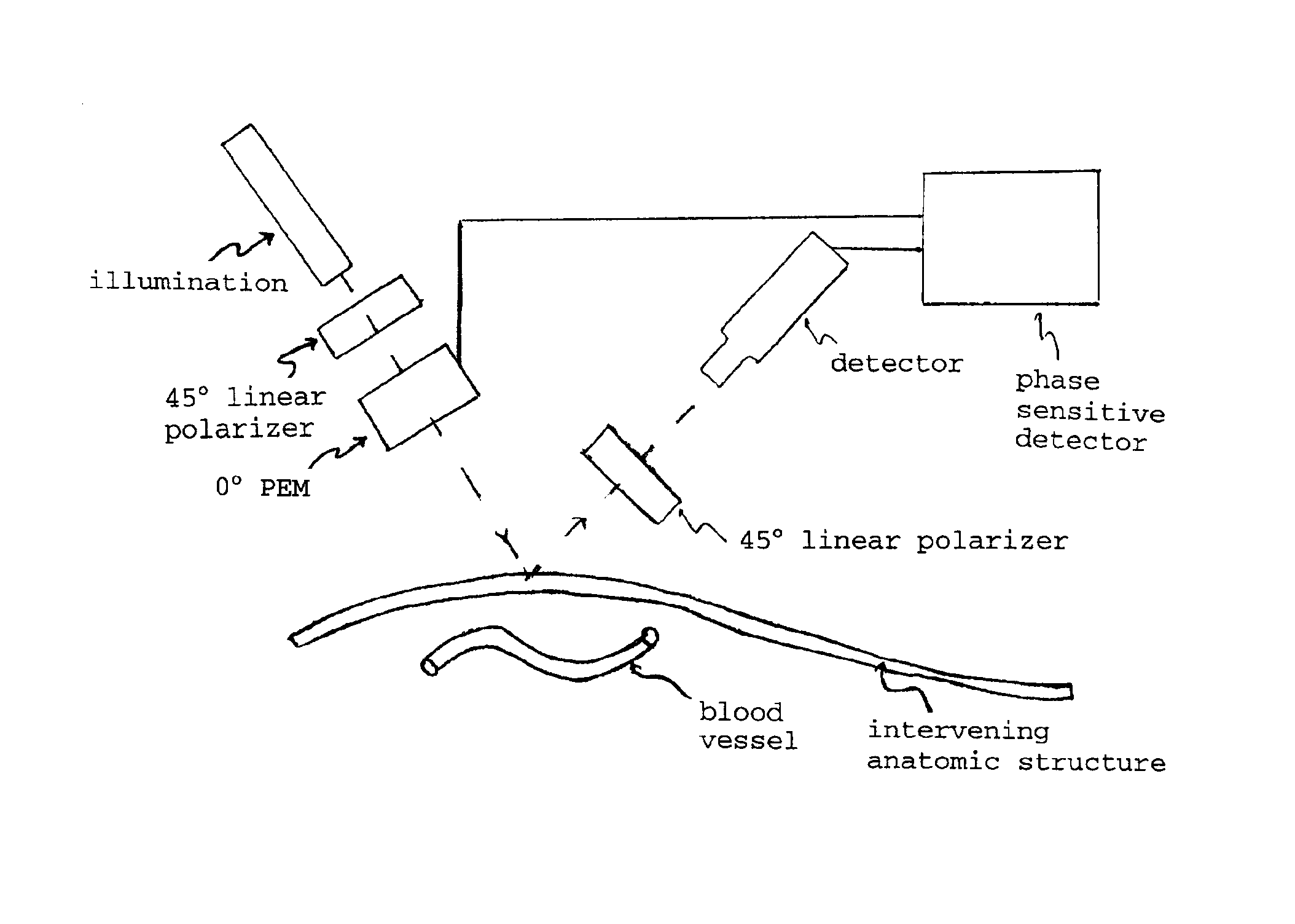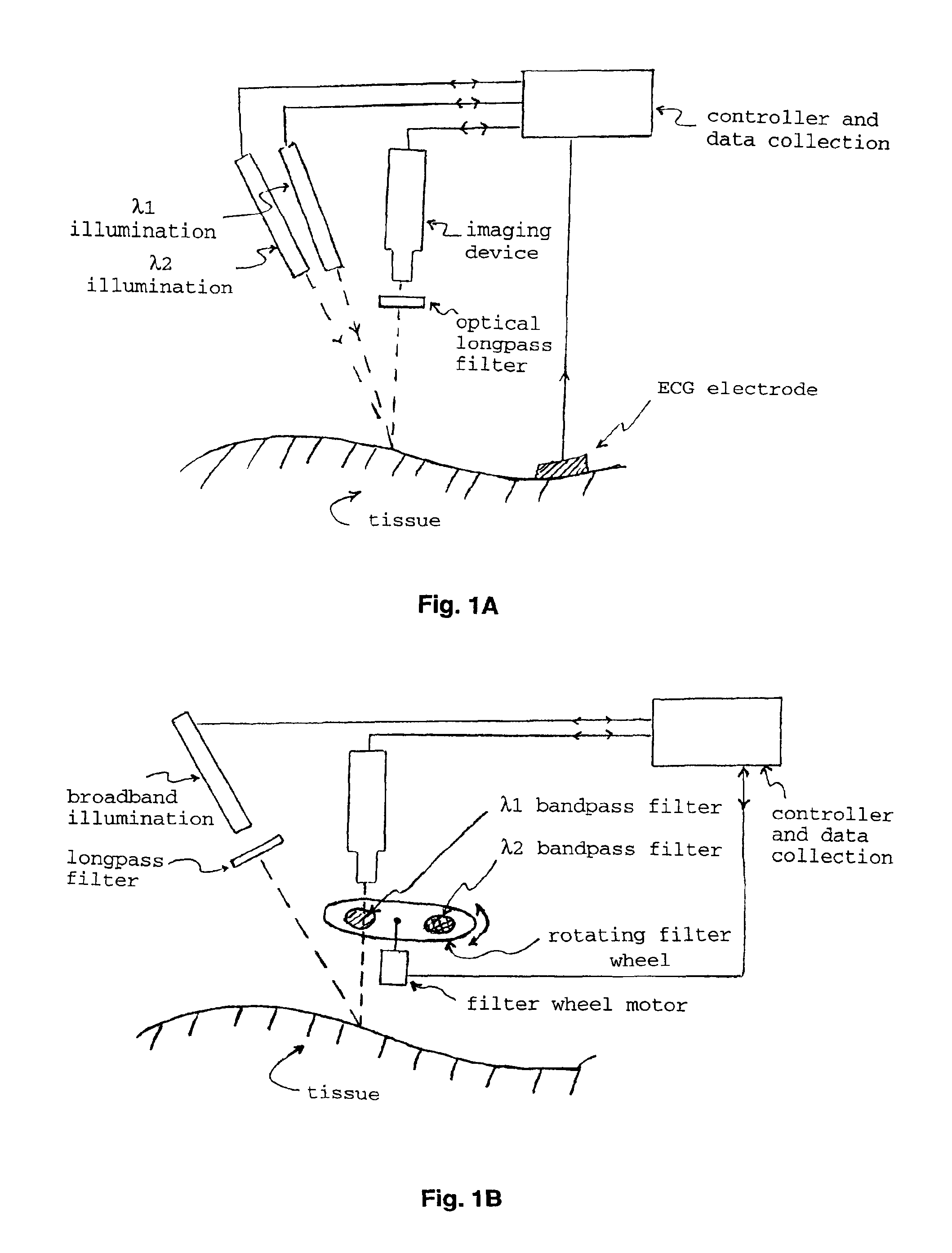Optical imaging of subsurface anatomical structures and biomolecules
a biomolecule and optical imaging technology, applied in the field of optical imaging and medical diagnosis, can solve the problems of deficient lack of effective means of imaging subsurface anatomical, use of ultraviolet, visible and infrared radiant electromagnetic energy for imaging, etc., and achieve enhanced imaging, enhanced contrast in medical imaging, and low cost
- Summary
- Abstract
- Description
- Claims
- Application Information
AI Technical Summary
Benefits of technology
Problems solved by technology
Method used
Image
Examples
example 1
Pulsatile Enhanced Imaging
[0029]Pulse oximeters are relatively common devices used to measure the percent oxygen saturation of blood, wherein red (λ1≈660 nm) and near infrared (λ2≈940 nm) radiant energy are passed through tissue (typically the fingertip). Using this device, it is possible to obtain a measurement of oxygen saturation of the blood based on the relative signals transmitted through the fingertips at each wavelength, knowing the absorption characteristics of the pertinent absorbing chromophores (tissue, oxygenated hemoglobin or HbO2, deoxygenated hemoglobin or Hb), and after extensive calibration of the device with a direct measurement of blood oxygenation. One important operating characteristic that makes the pulse-oximeters useful is that they can discern between arterial and non-arterial absorption by discriminating between time-varying signals (due to the heart pumping and more evident in arterial blood) and non-varying signals (venous blood and tissue).
[0030]FIG. 1 ...
example 2
Confocal Enhanced Imaging
[0034]The concept of rejecting light scattered from locations other than the point being imaged (that is, with coordinates x,y,z), by using apertures in the imaging system, is referred to as confocal imaging. This concept has been used to “optically section” microscopic specimens being viewed with a microscope. Confocal microscopy normally uses white light illumination, or ultraviolet to green illumination to induce fluorescence in the sample. The former illumination results in significant chromatic aberrations in the final image, while the latter provides only a fluorescent image.
[0035]It would be beneficial, in certain cases, to use red and / or near infrared radiant energy in a confocal imaging optical system, along with white-light illumination. Narrow band illumination through the use of diode lasers or bandpass filtered broadband light sources would be optimal (FIG. 2). By alternately illuminating the region-of-interest (ROI), for example, 660 nm and 940...
example 3
Raman Enhanced Imaging
[0036]Raman spectroscopy is a light scattering technique that uses (typically) laser radiation to excite the sample, whereby the scattered radiation emitted by the sample is analyzed. Emission data has two main characteristics: the frequencies at which the sample emits the radiation (a small number of the incident photons, perhaps only 1 in 106, is emitted at frequencies different from that of the incident light), and the intensities of the emissions. Determining the frequencies allows identification of the sample's molecular makeup, since chemical functional groups are known to emit specific frequencies and emission intensity is related to the amount of the analyte present. Now, with highly sensitive imaging light detectors (e.g. CCDs) and efficient optics such as transmission holographic gratings and notch filters, Raman spectroscopy has seen a resurgence of interest in the medical field.
[0037]It would be useful to illuminate the anatomic structure of interes...
PUM
 Login to View More
Login to View More Abstract
Description
Claims
Application Information
 Login to View More
Login to View More - R&D
- Intellectual Property
- Life Sciences
- Materials
- Tech Scout
- Unparalleled Data Quality
- Higher Quality Content
- 60% Fewer Hallucinations
Browse by: Latest US Patents, China's latest patents, Technical Efficacy Thesaurus, Application Domain, Technology Topic, Popular Technical Reports.
© 2025 PatSnap. All rights reserved.Legal|Privacy policy|Modern Slavery Act Transparency Statement|Sitemap|About US| Contact US: help@patsnap.com



